I am already dreaming of fall. Fall is a good time to add a fresh layer of mulch to the garden.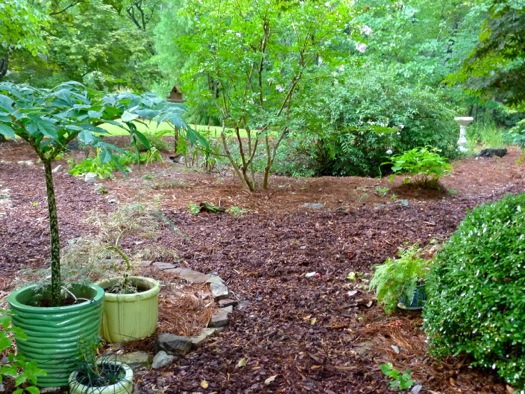 This view of the front garden shows wood chip paths and pine straw used as mulch. Good organic mulch has many uses and benefits:
This view of the front garden shows wood chip paths and pine straw used as mulch. Good organic mulch has many uses and benefits:
*Mulch is often beautiful and gives the garden a fresh and neat appearance.
*Mulch retains moisture around plants without making the soil soggy.
*Mulch helps to suppress weed growth.
*Mulch protects plant roots from temperature extremes in both summer and winter.
*As it breaks down, a good organic mulch will feed worms, beneficial fungi and micro-organisms in the soil.
*The worms and other earth dwellers will pull aging mulch into the soil, improving soil texture far better than any tiller and increasing soil nutrients available for plants.
*Mulch can prevent soil erosion.
*A layer of mulch around a plant will protect trunks from mowers and weed trimmers.
*Mulch helps to prevent soil compaction from foot traffic.
*Mulch can be used to create inexpensive but lovely paths.

There are some important things to know before applying mulch.
When applying mulch around a plant, be sure to leave a "doughnut hole" around the plant's trunk. Never pile mulch in a volcano next to the trunk. Also, do not apply more than a 2-3 inch deep layer of mulch around a plant. Wider is better than thicker. Too much mulch can make water difficult to penetrate through to the soil and over time can even suffocate plant roots.
Also, never apply mulch so that it touches your house. Termites will use the mulch as a pathway to your siding.
Here are some common mulches and how to use them:
Compost: Composted organic matter provides nutrients to both plants and soil organisms. It can be incorporated into the planting hole at planting time, as well as be used as a mulch on top of the ground. Because of its fine texture, compost is not as effective at preventing weeds as some other mulches.
Composted organic matter provides nutrients to both plants and soil organisms. It can be incorporated into the planting hole at planting time, as well as be used as a mulch on top of the ground. Because of its fine texture, compost is not as effective at preventing weeds as some other mulches.
Wood chips and shredded bark: These are beautiful mulches. Wood chips and shredded bark make great garden paths, but fresh wood chips and bark will pull nitrogen out of the soil as it ages, possibly decreasing available nitrogen for nearby plants. Therefore, use aged bark or chips around plants, rather than fresh. For the same reason, fresh mulch should not be incorporated into planting holes.
These are beautiful mulches. Wood chips and shredded bark make great garden paths, but fresh wood chips and bark will pull nitrogen out of the soil as it ages, possibly decreasing available nitrogen for nearby plants. Therefore, use aged bark or chips around plants, rather than fresh. For the same reason, fresh mulch should not be incorporated into planting holes.
Pine straw: This is an economical, attractive mulch. It contains compounds that inhibit seed germination, so it is great for suppressing weeds. It is acidic, so is beneficial for alkaline soil or for use around plants that like acid soil.
This is an economical, attractive mulch. It contains compounds that inhibit seed germination, so it is great for suppressing weeds. It is acidic, so is beneficial for alkaline soil or for use around plants that like acid soil.
Newspaper and cardboard: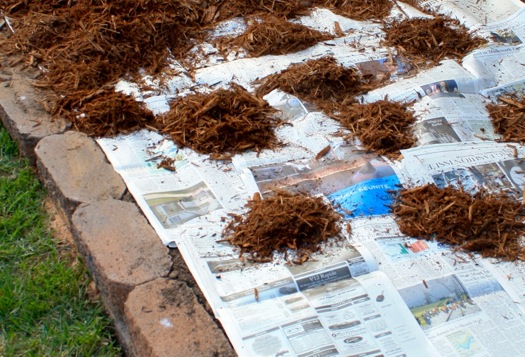 Newspaper or cardboard will block light and suppress weeds. Cover with another type of mulch for appearance. Newspaper and cardboard is very useful when establishing a new garden. There is no need to till or tediously pull or spray old vegetation. Simply cover the area with a layer of newspaper or cardboard, wet thoroughly, then top with several inches of good garden soil and plant. Avoid newsprint with colored dyes.
Newspaper or cardboard will block light and suppress weeds. Cover with another type of mulch for appearance. Newspaper and cardboard is very useful when establishing a new garden. There is no need to till or tediously pull or spray old vegetation. Simply cover the area with a layer of newspaper or cardboard, wet thoroughly, then top with several inches of good garden soil and plant. Avoid newsprint with colored dyes.
Straw: Straw or hay is often used in vegetable gardens. Unfortunately, it frequently contains weed seeds, and it provides the perfect environment for mice and voles. Its light color may not appeal to some gardeners.
Straw or hay is often used in vegetable gardens. Unfortunately, it frequently contains weed seeds, and it provides the perfect environment for mice and voles. Its light color may not appeal to some gardeners.
Pebbles and rocks: These look most at home in a rock garden (of course!) or a desert application. Pebbles and rocks absorb heat from the sunlight during the day, then release the heat at night, so they can help protect plants during chilly nights. Water drains through easily. An edging is needed to prevent the pebbles from washing away, and weeding can be a nightmare. A layer of landscape fabric beneath the rocks will postpone the weed problem but will not prevent it. In fact, it can make the problem worse. Landscape fabric deteriorates over time and will allow weeds to take hold. Believe me, pulling weeds through the rocks and landscape fabric can make the saintliest gardener cuss, and removing old landscape fabric is not fun, either. Pebbles and rocks are probably best used in applications where the gardener can spray weeds without worrying about harming plants, such as paths and parking areas. Forget the landscape fabric.
These look most at home in a rock garden (of course!) or a desert application. Pebbles and rocks absorb heat from the sunlight during the day, then release the heat at night, so they can help protect plants during chilly nights. Water drains through easily. An edging is needed to prevent the pebbles from washing away, and weeding can be a nightmare. A layer of landscape fabric beneath the rocks will postpone the weed problem but will not prevent it. In fact, it can make the problem worse. Landscape fabric deteriorates over time and will allow weeds to take hold. Believe me, pulling weeds through the rocks and landscape fabric can make the saintliest gardener cuss, and removing old landscape fabric is not fun, either. Pebbles and rocks are probably best used in applications where the gardener can spray weeds without worrying about harming plants, such as paths and parking areas. Forget the landscape fabric.
Dyed wood mulch: Wooden pallets and various types of wood trash are chopped up and dyed. This mulch may contain harmful chemicals, including creosote and arsenic. Rain will wash the color out of the wood, and you may see it running onto your patio or drive. Some people like the colors, but I would never use it.
Wooden pallets and various types of wood trash are chopped up and dyed. This mulch may contain harmful chemicals, including creosote and arsenic. Rain will wash the color out of the wood, and you may see it running onto your patio or drive. Some people like the colors, but I would never use it.
Dyed rubber mulch:  This stuff is made from old rubber tires. Instead of being disposed of in a toxic waste dump, the tires are shredded and dyed in an assortment of colors, packaged nicely and then sold as mulch. It stinks like petroleum in the summer and leaches pollutants into the environment. To my horror, rubber mulch is often used on playgrounds. Never put this material in your garden.
This stuff is made from old rubber tires. Instead of being disposed of in a toxic waste dump, the tires are shredded and dyed in an assortment of colors, packaged nicely and then sold as mulch. It stinks like petroleum in the summer and leaches pollutants into the environment. To my horror, rubber mulch is often used on playgrounds. Never put this material in your garden.
Here is another view of mulch used in my garden. It has been raining, so everything looks fresh.
Imagine what my garden would look like if all the mulched areas were bare dirt and weeds!
 Sunday, April 14, 2019 at 11:30PM
Sunday, April 14, 2019 at 11:30PM 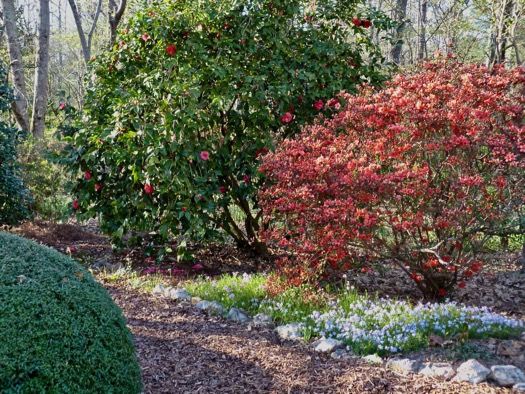

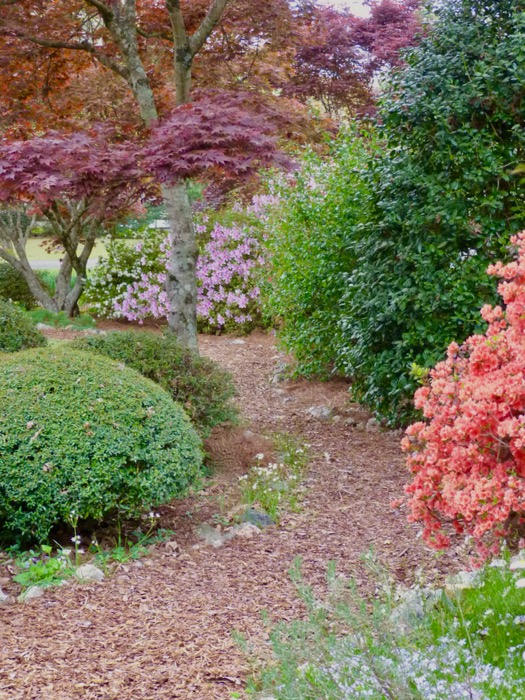
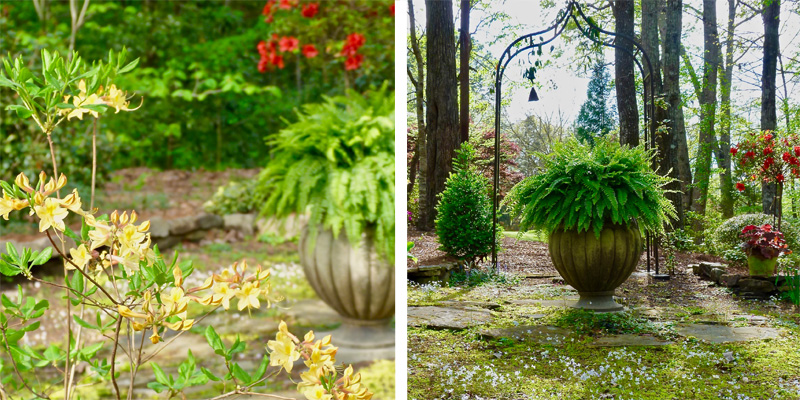
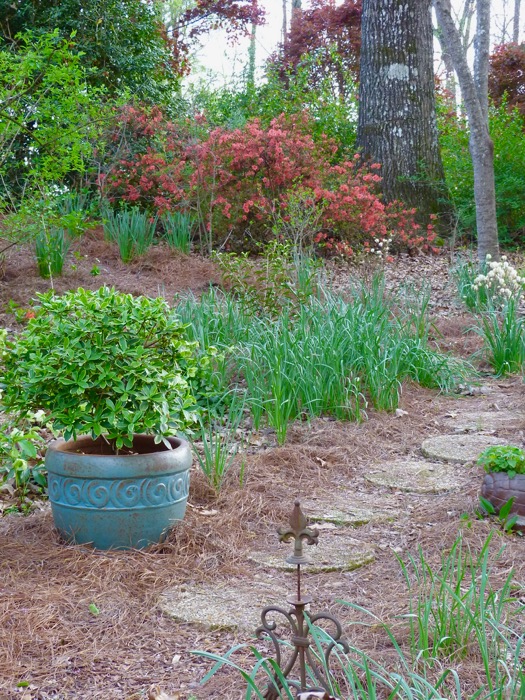

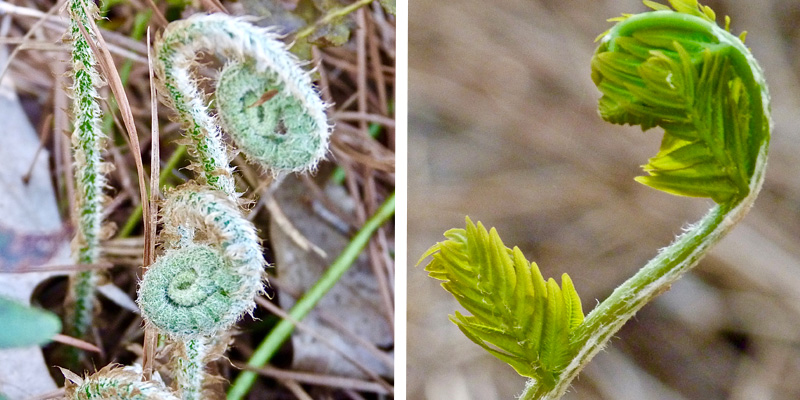


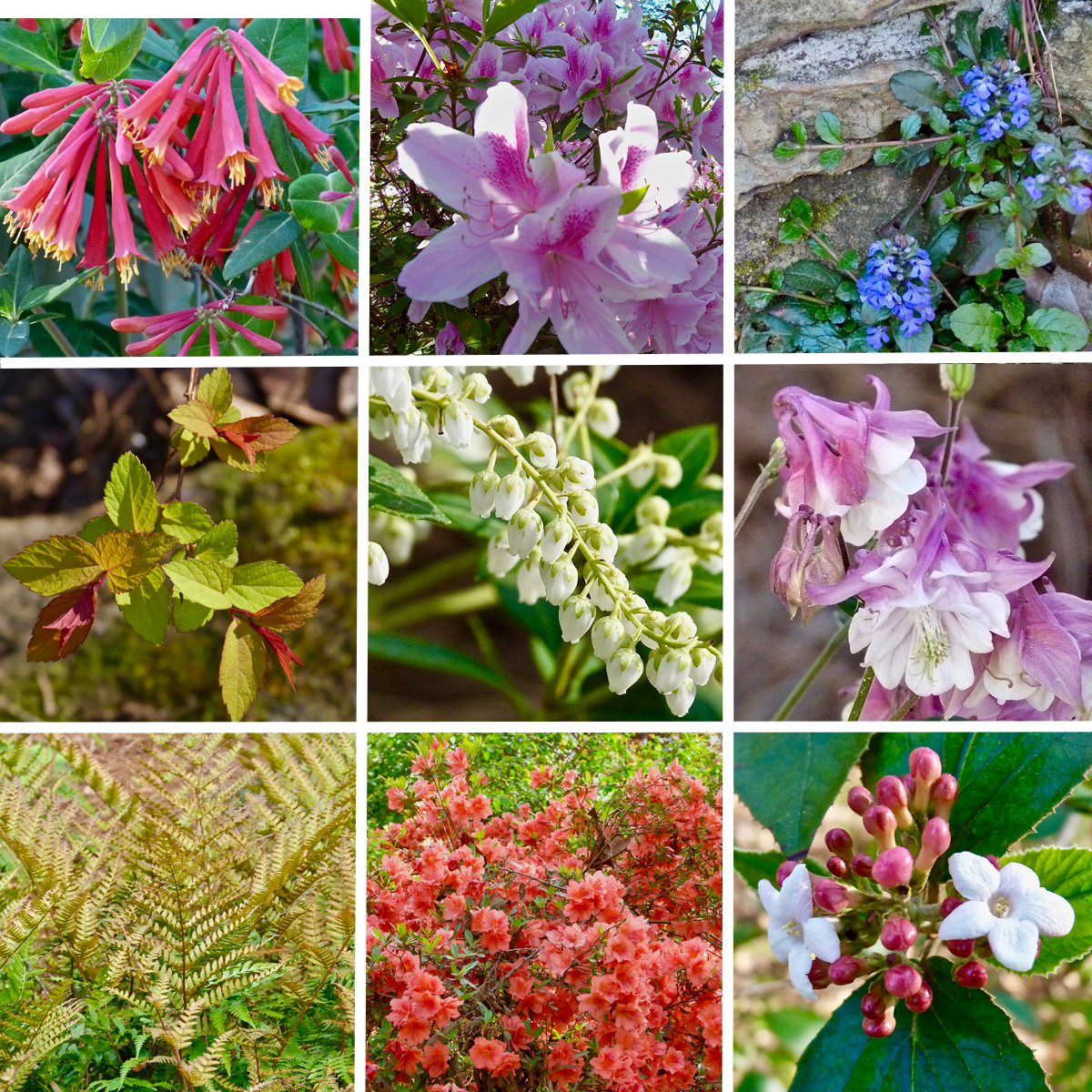 1st row: Honeysuckle 'Major Wheeler'; Azalea 'George L. Tabor'; Common Ajuga. 2nd row: Spirea 'Candy Corn'; Pieris 'Cavatine'; Hybrid Columbine. 3rd row: Autumn Fern; Orange Karume Azalea; Korean Spice Viburnum.Here is a close-up of a colorful euphorbia:
1st row: Honeysuckle 'Major Wheeler'; Azalea 'George L. Tabor'; Common Ajuga. 2nd row: Spirea 'Candy Corn'; Pieris 'Cavatine'; Hybrid Columbine. 3rd row: Autumn Fern; Orange Karume Azalea; Korean Spice Viburnum.Here is a close-up of a colorful euphorbia: 











